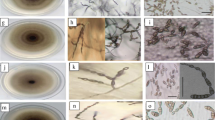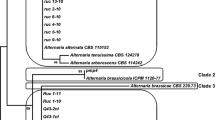Abstract
Early blight is a common disease of Solanaceae crops worldwide. The occurrence of Alternaria spp. was studied during three epidemics on tomato in northwestern Algeria. Alternaria was detected in more than 80 % of the diseased plant samples and accounted for more than 50 % of the total fungal isolates recovered from these samples. Morphological and molecular investigations revealed that small-spored isolates producing beaked conidia, i.e. belonging to the section alternaria, were prominent in most of the surveyed locations representing more than 80 % of the total Alternaria isolates in three locations (Mascara, Ain Témouchent and Sidi Belabbèsse). Based on their sporulation patterns they were recognized as A. alternata and A. tenuissima. Small-spored isolates producing conidia without beak and assigned to A. consortialis were also found at a low frequency (< 1 %). Large-spored isolates producing conidia ended by typical long beaks and identified as A. linariae (syn. A. tomatophila), A. solani and A. grandis were also recovered from all the sampled areas and represented 33.8 %, 6.3 % and 1.3 % of the total Alternaria isolates, respectively. Pathogenicity tests on tomato with a selection of 85 strains representative of the isolates collection revealed that all the tested isolates were able to produce extending lesions on inoculated leaves albeit with variable intensity. Large-spored species included the most aggressive isolates. Small-spored Alternaria, although less aggressive than large-spored Alternaria, had the ability to provoke brown necrotic spots and circumstantially developed synergistic interactions in mixed infections with moderately aggressive isolates of A. linariae.








Similar content being viewed by others
References
Abada, K. A., Mostafa, S. H., & Mervat, R. (2008). Effect of some chemical saltson suppressing the infection by early blight disease of tomato. Egyptian Journal of Applied Science, 23, 47–58.
Akagi, Y., Akamatsu, H., Otani, H., & Kodama, M. (2009). Horizontal chromosome transfer, a mechanism for the evolution and differentiation of a plant-pathogenic fungus. Eukaryotic Cell, 8, 1732–1738.
Andersen, B., Dongo, A., & Pryor, B. M. (2008). Secondary metabolite profiling of Alternaria dauci, A. porri, A. solani, and A. tomatophila. Mycological Research, 2(2), 241–250.
Bashan, Y., Levanony, H., & Or, R. (1991). Association between Alternaria macrospora and Alternaria alternata, causal agents of cotton leaf blight. Canadian Journal of Botany, 69, 2603–2607.
Basu, P. K. (1974). Measuring early blight, its progress and influence on fruit losses in nine tomato cultivars. Canadian Plant Disease Survey, 54, 45–51.
Berbee, M. L., Pirseyedi, M., & Hubbard, S. (1999). Cochliobolus phylogenetics and the origin of known, highly virulent pathogens, inferred from ITS and glyceraldehyde-3-phosphate dehydrogenase gene sequences. Mycologia, 91, 964–977.
Bessadat, N., Simoneau, P., Benichou, S., Setti, B., Kihal, M., & Henni, J. E. (2014). Morphological, physiological and pathogenic variability of small-spore Alternaria causing leaf blight of Solanaceae in Algeria. African Journal of Microbiology Research, 8(37), 3422–3434.
Bessadat, N., Hamon, B., Henni, J. E., & Simoneau, P. (2016). First report of tomato early blight caused by Alternaria grandis in Algeria. Plant Disease, 100, 533.
Boedo, C., Benichou, S., Berruyer, R., Bersihand, S., Dongo, A., Simoneau, P., et al. (2012). Evaluating aggressiveness and host range of Alternaria dauci in a controlled environment. Plant Pathology, 61, 63–75.
Carbone, I., & Kohn, L. M. (1999). A method for designing primer sets for speciation studies in filamentous ascomycetes. Mycologia, 91, 553–556.
Chaerani, R., & Voorrips, R. E. (2006). Tomato early blight (Alternaria solani ): the pathogen, genetics, and breeding for resistance (review). Journal of General Plant Pathology, 72, 335–347.
Datar, V. V., & Mayee, C. D. (1981). Assessment of loss in tomato yield due to early blight. Indian Phytopathology, 34, 191–195.
Dereeper, A., Guignon, V., Blanc, G., Audic, S., Buffet, S., Chevenet, F., et al. (2008). Phylogeny.fr: robust phylogenetic analysis for the non-specialist. Nucleic Acids Research, 2008 Jul 1; 36 (Web Server Issue):W465–9. Epub 2008 Apr 19, from http://www.phylogeny.fr/.
Dhingra, O. D., & Sinclair, J. B. (1995). Basic plant pathology methods. Boca Raton, FL: CRC Lewis.
Fahim, M. M. (1966). The effect of light and other factor in the sporulation of Alternaria porri. Transactions of the British Mycological Society, 49(1), 73–78.
Fraser, J. T., & Zitter, T. A. (2003). Two species of Alternaria cause early blight of potato (Solanum tuberosum) and tomato (Lycopersicon esculentum). Phytopathology, 93, (supplement) S3.
Gannibal, P. B., Orina, A. S., Mironenko, N. V., & Levitin, M. M. (2014). Differentiation of the closely related species, Alternaria solani and A. tomatophila, by molecular and morphological features and aggressiveness. European Journal of Plant Pathology, 139, 609–623.
Gardes, M., & Bruns, T. D. (1993). ITS primers with enhanced specificity for basidiomycetes- application to the identification of Mycorrhizae and rusts. Molecular Ecology, 2, 113–118.
Goodwin, D. C., & Lee, S. B. (1993). Microwave miniprep of total genomic DNA from fungi, plants, protists and animals for PCR. BioTechniques, 15, 438–444.
Grigolli, J. F. J., Kubota, M. M., Alves, D. P., Rodrigues, G. B., Cardoso, C. R., Henriques da Silva, D. J., & Mizubuti, E. S. G. (2011). Characterization of tomato accessions for resistance to early blight. Crop Breeding and Applied Biotechnology, 11, 174–180.
Grogan, R. G., Kimble, K. A., & Misaghi, I. (1975). A stem canker disease of tomato caused by Alternaria alternate f.sp. lycopersici. Phytopathology, 65, 880–886.
Jones, L. R., & Grout, A. J. (1897). Notes on two species of Alternaria. Bulletin of the Torrey Botanical Society, 24, 254–258.
Kemmitt, G. (2002). Early blight of potato and tomato. The Plant Health Instructor. doi:10.1094/PHI-I-2002-0809-01.
Kirk, W. W., Schafer, R. L., Tumbalan, P., & Wharton, P. (2007). Evaluation of fungicide programs for potato early blight and brown leaf spot control. Plant Disease Management Report, 2(V065), 1–2.
Konstantinova, P., Bonants, P. J. M., van Gent-Pelzer, M. P. E., van der Zouwen, P., & van den Bulk, R. (2002). Development of specific primers for detection and identification of Alternaria spp. in carrot material by PCR and comparison with blotter and plating assays. Mycological Research, 106, 23–33.
Kozlovski, B. E., & Kvasnyuk, N. Y. (1984). Stimulation of sporulation of Macrosporium solani ell. Mart. on nutrient media with potato leaf extracts. Mikologiya i Fitopatologiya, 18(2), 139–140.
Lawrence, D. P., Gannibal, P. B., Peever, T. L., & Pryor, B. M. (2013). The sections of Alternaria: formalizing species-groups concepts. Mycologia, 105, 530–546.
Leiminger, J., Bahnweg, G., & Hausladen, H. (2010). Population genetics – consequences on early blight disease. Twelfth Euro Blight workshop -PPO-Special Report, 14, 171–178.
Lourenço Jr., V., Moya, A., González-Candelas, F., Carbone, I., Maffia, L. A., & Mizubuti, E. S. G. (2009). Molecular diversity and evolutionary processes of Alternaria solani in Brazil inferred using genealogical and coalescent approaches. Phytopathology, 99, 765–774.
Orina, A. S., Gannibal, P. B., & Levitin, M. M. (2010). Species diversity, biological characters and geography of Alternaria Fungi associated with solanaceous plants. Mikologiya i Fitopatologiya, 44, 150–159.
Pryor, B. M., & Gilbertson, R. L. (2000). Molecular phylogenetic relationships amongst Alternaria species and related fungi based upon analysis of nuclear ITS and mt SSU rDNA sequences. Mycological Research, 104, 1312–1321.
R Core Team (2016). R: A language and environment for statistical computing. R Foundation for Statistical Computing, Vienna, Austria. URL https://www.R-project.org/.
Rodrigues, T. T. M. S., Berbee, M. L., Simmons, E. G., Cardoso, C. R., Reis, A., Maffia, L. A., et al. (2010). First report of Alternaria tomatophila and A. grandis causing early blight on tomato and potato in Brazil. New Disease Reports, 22, 28. doi:10.5197/j.2044-0588.2010.022.028.
Rotem, J. (1994). The Genus Alternaria: biology, epidemiology, and pathology. St Paul, MN: American Phytopathological Society Press.
Rotem, J., Bashi, E., & Kranz, J. (1983). Studies of crop loss in potato blight caused by Phytophthora infestans. Plant Pathology, 32(2), 117–122.
Runa, F., Soo Park, M., & Pryor, B. (2009). Ulocladium systematics revisited: phylogeny and taxonomic status. Mycological Progress, 8, 35–47.
Saleemi, M. K., Khan, M. Z., Khan, A., Javed, I., Ul Hasan, Z., Hameed, M. R., et al. (2012). Occurrence of toxigenic fungi in maize and maize-gluten meal from Pakistan. Phytopathologia Mediterranea, 5(1), 219–224.
Simmons, E. G. (1967). Typification of Alternaria, Stemphylium, and Ulocladium. Mycologia, 59, 67–92.
Simmons, E. G. (2000). Alternaria themes and variations (244-286) species on Solanaceae. Mycotaxon, 75, 1–115.
Simmons, E. G. (2007). Alternaria. An identification manual: CBS Biodiversity Series No. 6. CBS Fungal Biodiversity Centre, Utrecht, the Netherlands. 775 pp.
Snoussi, S. A. (2009). Etude de base sur la tomate en Algérie. Programme régeional de gestion intégrée des ravageurs pour le Proche-Orient. from http://www.ipm-neareast.com.
Spoelder, J., Ellens, R., & Turkensteen, L. (2014). Comparing pathogenicity of Alternaria alternata and Alternaria solani on potato. Fourteenth Euroblight Workshop. PPO – Special Report, 16, 97–102.
Spurr Jr., H. W. (1977). Protective applications of conidia of non-pathogenic Alternaria alternata isolates for control for brown tobacco brown spot disease. Phytopathology, 67, 128–132.
Stammler, G., Bohme, F., Philippi, J., Miessner, S., & Tegge, V. (2014). Pathogenicity of alternaria-species on potatoes and tomatoes. Fourteenth Euroblight Workshop PPO – Special Report, 16, 85–96.
Van den Heuvel, J. (1971). Antagonism between pathogenic and saprophytic Alternaria species on bean leaves. In T. E. Preece & C. H. Dickinson (Eds.), Ecology of leaf surface micro-organisms. New York: Academic Press.
Van Der Waals, J. E., Korsten, L., Avelino, T. A. S., & Denner, F. D. N. (2003). Influence of environmental factors of Alternaria solani conidia above a south African potato crop. Phytoparasitica, 31(4), 353–364.
Weir, T. L., Huff, D. R., Christ, B. J., & Romaine, C. P. (1998). RAPD-PCR analysis of genetic variation among isolates of Alternaria solani and Alternaria alternata from potato and tomato. Mycologia, 90, 813–821.
White, T. J., Bruns, T., Lee, S., & Taylor, J. (1990). Amplification and direct sequencing of fungal ribosomal RNA genes for phylogenetics. In M. A. Innis, D. H. Gelfand, J. J. Sninsky, & T. J. White (Eds.), PCR protocols: a guide to methods and applications (pp. 315–322). San Diego, CA: Academic Press.
Woudenberg, J. H. C., Groenewald, J. Z., Binder, M., & Crous, P. W. (2013). Alternaria redefined. Studies in Mycology, 75, 171–212.
Woudenberg, J. H. C., Truter, M., Groenewald, J. Z., & Crous, P. W. (2014). Large spore Alternaria pathogens in section Porri disentangled. Studies in Mycology, 79, 1–47.
Woudenberg, J. H. C., Seidi, M. F., Groenewald, J. Z., de Vries, M., Stielow, J. B., Thomma, B. P. H. J., et al. (2015). Alternaria section Alternaria: species, formae speciales or pathotypes. Studies in Mycology, 82, 1–21.
Zhang, T. Y. (2003). Flora Fungorum Sinicorum. vol. 16, The genus Alternaria (pp. 1–281). Beijing: Science Press.
Acknowledgments
Part of this work was done during a stay at the University of Angers- France, financed by a grant from the University of Oran.
Author information
Authors and Affiliations
Corresponding author
Electronic supplementary material
Online resource 1
Scale used to estimate disease severity on tomato leaves inoculated by Alternaria spp. (TIFF 1141 kb)
Online resource 2
Representative results of the analysis of PCR products obtained after amplification on DNA extracted from symptomatic tomato tissues with primer sets (A) ITSF1–4, (B) AAF2-R3, (C) OAtF4-R2, and (D) OAtF7-R6 specific for fungi, Alternaria spp. of the alternata section, A. linariae, and A. solani, respectively. Lanes 1 correspond to positive controls and were loaded with PCR products obtained after amplification with relevant primer sets from DNA of either A. alternata CBS916.96 (A, B) or A. linariae EGS-44-024 (C) or A. solani (CBS110.41). Infected tomato samples were collected in Oran (lanes 2, 8, 12), Mostaganem (lanes 3, 5), Tlemcen (lanes 4, 11), Ain Témouchent (lanes 3, 6, 10), Mascara (lane 7) and Sidi Bel Abbèsse (lane 9). Lanes M were loaded with the molecular marker. Approximate sizes (in bp) of the amplification products are indicated on the left. (TIFF 494 kb)
Online resource 3
Effect of cross inoculations on disease severity: Student t-test associated p-values. (DOCX 62 kb)
Rights and permissions
About this article
Cite this article
Bessadat, N., Berruyer, R., Hamon, B. et al. Alternaria species associated with early blight epidemics on tomato and other Solanaceae crops in northwestern Algeria. Eur J Plant Pathol 148, 181–197 (2017). https://doi.org/10.1007/s10658-016-1081-9
Accepted:
Published:
Issue Date:
DOI: https://doi.org/10.1007/s10658-016-1081-9




